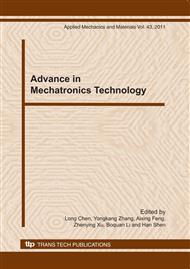p.225
p.229
p.233
p.238
p.242
p.247
p.253
p.257
p.262
A Novel Fuzzy-PID HFFT Controller to Advance on the Dynamic Characteristics
Abstract:
Structural components are subjected to high-frequency vibration. But today, the fatigue tester is required to provide higher precision, robust system performance and more powerful functionality because of the increasing arduousness of industrial material selection. The novel fuzzy-PID HFFT (High frequency fatigue tester) controller advances on the static/dynamic load accuracy, the running stability, the resonant frequency seeking ability, and the frequency stability. Firstly the HFFT mechanical system model is introduced. Secondly the HFFT controller is developed, which includes the static/dynamic load control loop and the frequency locked loop. Finally some experimental data in PLG-100 are shown. Compared to the conventional PID system, the fuzzy-PID tester’s accuracy is higher, and the load/frequency control loops possess the premium dynamic characteristics.
Info:
Periodical:
Pages:
242-246
Citation:
Online since:
December 2010
Authors:
Keywords:
Price:
Сopyright:
© 2011 Trans Tech Publications Ltd. All Rights Reserved
Share:
Citation:


